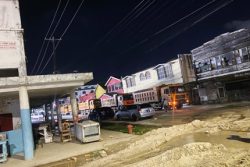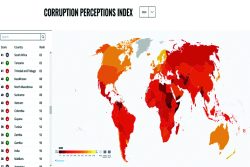Guyana is often mentioned for less than stellar reasons. There’s Jonestown (‘(s)he drank the Kool Aid’), rigged elections, the poorest country after Haiti in CARICOM and Latin America, the costliest failed infrastructural project in CARICOM (US$250M Skeldon sugar factory), and failed or captured regulatory agencies. Standouts among the latter was the Guyana Elections Commission (GECOM) in 2020 and the Environmental Protection Agency (EPA) in 2021. This article considers the EPA’s (non)regulation of US multinational ExxonMobil (XOM) and companies that provide services to XOM.
XOM struck commercial quantities of oil in Guyana’s Exclusive Economic Zone (EEZ) in 2015. Through Esso Exploration and Production Guyana Limited (EEPGL), its affiliate company incorporated in Guyana, XOM is pumping ‘light sweet crude’ 24/7, and flaring the associated natural gas, the latter in violation of the clause in the Production Sharing Agreement (PSA 2016) to re-inject associated gases and produced water back into the petroleum reservoir.
What has the average Guyanese received in return to date? The sobering answer is that while Guyanese are nominal owners of public natural resources, including oil and gas, forests and minerals, in practice the Executive arm of government exercises single-handed control over drawing up, issuing and monitoring of contracts. Thanks to our 1980 Constitution, the Executive arm of government also has sole control over the earnings from oil lifts and 2% royalty payments on the oil sold. For reasons beyond the scope of this article, those payments lie dormant in the New York Federal Reserve Bank in New York. In the meantime, the government is borrowing heavily for infrastructural constructions and handouts to citizens, presumably expecting to pay off the debts through future oil revenue. Guyana’s external debt stood at US$1.35 billion as of March 2021. But this seems to overlook the unfettered ability of XOM to charge almost unlimited and unpredictable costs to the government of Guyana, which has been unable to complete an audit of any XOM costs to determine which are and which are not chargeable under the PSA. Chris Ram, auditor, has repeatedly drawn attention to anomalies in EEPGL’s (the Operator) pre-contract and contract claims, and is repeatedly ignored.
In Guyana, once a natural resources contract is issued, the holder of that contract treats it as private property. Already petroleum contracts are being traded and sold by licensees, without any reference to or involvement of the Guyanese nominal owners of the resource. The renter or seller reaps the profits; the owner, Guyana, inherits the negative externalities – befouled ocean and rivers, forests and riverbeds and riverbanks dug up for gold and diamonds, forests stripped of commercially desirable trees and wildlife, including ‘racing’ birds … in disregard of natural resources laws, regulations and policies.
According to the terms of its 2016 PSA, Guyana pays all of ExxonMobil’s costs of production. Those costs include the provision of foodstuff, local and international accommodation and travel for the more than 1,000 persons who work onshore or offshore, on the FPSO and supply vessels. ExxonMobil can and does pay top dollar for airfares, local food supplies and ground transportation, etc. At the end of the supply chain, the Guyanese woman-or-man-in-the-street feels the inflationary effects in the high and rising cost of living, notably for housing, food prices and transportation.
Petroleum extraction involves the generation of large amounts of waste of many different kinds and toxicities. Guyana has no prior experience of handling either the types or quantities of waste from 1, let alone 10, Floating Production Storage and Offloading (FPSO) vessels. Guyana’s EPA has almost no independent capacity to monitor what is produced from the deepwater oil fields, or what happens to the component and derived products, or what are the environmental impacts. Instead, the EPA acts as cheerleader for ExxonMobil and the associated companies, which the EPA is mandated to police under the Environmental Protection (EP) Act.
For the harried Guyanese, the serial announcements of more billions of barrels of oil found offshore translate into more petroleum-generated wastes, including radioactive wastes, that are transported to our shores and foisted onto hapless communities. Here is how the unequal exchange works: Light sweet crude oil is transported by tanker to XOM’s refineries in the southern USA, and to other petroleum refineries. The waste products from exploration and production are transported to Guyana … our country relegated to serving as EEPGL’s garbage dump.
In Guyana’s EEZ, and in the surrounding Caribbean Sea, marine animals from turtles to the seabob shrimp may be shrivelling from the continuous discharge of cooling water (heated to 30 degrees Celsius, more than thrice the temperature of the surrounding ocean). In addition, EEPGL dumps into the ocean the toxic produced water that is only partly de-contaminated.
From late March to May 2021 the community of Coverden was learning about and organizing their appeals against the ‘Global Oil Environmental Services’ (GOES) company that had been given the all-clear from the EPA to construct and operate a waste treatment facility for the transfer, storage, treatment, and disposal of Exploration and Production (E&P) oil & gas waste in Coverden. On 1 June 2021, they learned from a Press article that a Second Coverden waste treatment facility gets EPA approval. That second facility was a Trinidadian company, Non Destructive Testers, and its application should have triggered a reminder at the EPA about the need to consider cumulative effects. Instead, the EPA waived the requirement for Environmental Impact Assessments (EIAs) for waste disposal facilities, including for radioactive waste products, located in the midst of residential communities on the East Bank of Demerara: Schlumberger’s at Houston, and GOES and Non Destructive Testers Limited at Coverden.
In contravention of Section 11 of its own Act, the EPA has not provided either a public summary or the reasons for waiving the EIAs. As noted in a recent Stabroek News editorial: ‘Moreover, the statutory agency meant to protect the environment, the Environmental Protection Agency operates mostly as an adjunct to the runaway oil extraction plans as evidenced by its decisions not to require Environmental Impact Assessments for key projects’ (https://www.stabroeknews.com/2021/10/18/opinion/editorial/ten-billion-and-counting/).
In June 2021 four written appeals were sent to the EPA, protesting its waiver of the requirement for an EIA from Non Destructive Testers Limited. Three of the appellants were from the community of Coverden. The only documentation posted by the EPA at the announcement of its waiver was a 5-page ‘Attachment #1’ – of a larger (not provided) ‘Environmental Authorisation form for Nuclear Safety and Radiation Protection’. The appeals were submitted within the stipulated 28 days window and that triggered the convening by the Environmental Assessment Board (EAB) of a ‘public hearing’ on 9 September 2021.
The first of the five pages of ‘Attachment #1’ listed information on the Trinidadian parent company: ‘Occupation and nature of business’. Pages 2-4 listed the services provided and page 5 contained a chart titled ‘Extraction of organization chart showing lines of communication for all radiation safety matters’. At the head of the chart is the named Managing Director/Radiation Protection Supervisor. There are two Notes under the chart; the first note reads ‘Contact information for all RPS and RSO are listed in the Radiation Safety Manual’; the latter was not provided.
The procedure for the hearing convened by the EAB was: firstly, a presentation by Non Destructive Testers Guyana Limited; followed by 15 minutes for each appellant to make their case; and finally for the EPA to say why the requirement for an EIA had been waived. The presentation by Non Destructive Testers made clear that the caption of the June 1 Stabroek News article (Second Coverden waste treatment facility gets EPA approval) was not the full truth: Non Destructive Testers is not only a waste handing facility. It stores calibration radioactive material and transports that material offsite to use to calibrate equipment. So you have storage and movement of calibration isotopes. The radioactive calibrators and tracers will, inevitably, become waste at some time so local people living around these new industrial enterprises are justified in asking for more information. Appellants pointed out the risks posed by having a facility handling radioactive materials operating in the midst of a community and that there had been no stakeholder consultation on this project. Furthermore, they urged the EPA to undertake a country-wide educational campaign on radioactive materials: ‘What affects Coverden will affect all seven races, all 83,000 square miles. Mixed Race people are a race.’
I was able to listen in on the Public Hearing via Zoom and I share below some of the appellants’ comments, as transcribed by me (I do not have access to the oral recordings so these comments are not verbatim).
On a facility dedicated to storage of radioactive materials
Appellant: 1. ‘I say one word … Chernobyl.’
Comment: During the public hearing, an EAB Commissioner asked the EPA representative present how the Non Destructive Testers facility compared with Chernobyl. The EPA spokesperson said that Chernobyl was ranked in category 1, whereas the Coverden facility was ranked as Category 2. One of the appellants interjected at that point to say that in the USA, the headquarters of XOM, categories 1 and 2 automatically require an EIA.
Other comments and questions from Appellants:
2. ‘The developer presented a best-case scenario. However, for us, living in Coverden, we are concerned with the risks to us, to our land, to our way of life.’
3. ‘You have said nothing about natural disasters.’
4. ‘The Non Destructive Testers spokesperson said a minute ago that the equipment would not be stolen, that people are generally scared of radioactive materials. You [spokesperson] answered for us all … people are generally scared of radioactive materials.’
5. ‘Will you take that chance to expose you or your family to radiation?’
6. ‘What safety nets do you have in place?’
7. ‘How do you plan to enforce monitoring and evaluation (M&E)?’
8. ‘I also ask that you have independent monitoring, to ensure compliance.’
9. ‘I ask EPA to use standards comparable to those in developed countries.’
10. ‘You said that the technicians will be sent for re-evaluation every month. What about us, the community members?’
11. ‘Does Guyana have the medical facilities to treat radioactive exposure? What is the protocol you use?’
12. ‘EPA needs to establish baseline information. There are no empirical or scientific findings. No assessment was done by the EPA to have a basis for comparison. EPA is giving companies permission to build industrial-scale facilities in residential areas.’
Comment: While some of the questions were rhetorical, none was answered clearly by the EPA spokespersons.
On a facility dedicated to movement of equipment to carry out tests of radioactive materials located elsewhere
One of the appellants alleged that the 5-pager submission disingenuously suggested that the Non Destructive Testers facility was to be used for storage. However, everyone was learning during the public hearing that this facility would be in active operation.
13. ‘Now we hear today that the company will transport the equipment to client company sites. But no details on which roads they will be using? It is clearly evident from his question that even our EAB Chair did not know on which roads the equipment will be moved.’
14. ‘What happens if there is an accident, and there is a spill?’
15. ‘That East Bank Demerara road is the only road that Coverden and Guyanese people know, use … there is no escape route. You located safe in Trinidad … you don’t care.’
Comments:
#13: It was only at this public forum that Omkar Lochan, the head of the EAB, discovered for the first time that the purpose of the Non Destructive Testers facility was to hold the materials AND transport them to be used at various sites. It was a testimony to the fact that the information provided to the public prior to the hearing was so deficient that the head of the EAB himself was only at the hearing discovering the purpose and main activity of the project.
#13-15: The EPA spokesperson gave two answers to the points raised. First, that the Agency did a desktop exercise in 2019 but could not run a practical demonstration on account of Covid 19. Second, that Non Destructive Testers also had emergency response procedures.
The appellants had a lot more to say about procedural and substantive failures of the EPA and EAB, including the need for citizen engagement – in line with Section 4. (1) of the Environmental Protection (EP) Act which states: ‘The functions of the Agency are –
(b) to promote the participation of members of the public in the process of integrating environmental concerns in planning for development on a sustainable basis’.
Furthermore, Section 17 of the EP Act sets out the Agency’s responsibility to take cumulative effects into account: ‘(1) Where any activity by itself does not have a significant effect on the environment but the same activity or similar activities are carried out by any person in any place and cumulatively may significantly affect the environment, the Agency shall require to be carried out an environmental impact assessment of the cumulative effects of such activities by such persons.”
The application of the precautionary principle would indicate the desirability of having a single comprehensive waste management plan incorporating best international practices.
The Stabroek News article of June 1, 2021, referenced above, included an interview with former EPA Head, Vincent Adams, in which he reflected on the EPA and Coverden:
‘When asked about the general concern of residents about the location and treatment of hazardous waste coming from oil and gas production. Dr. Adams said that he had introduced a ‘cradle to grave’ principle used in the US regulations and set it as a requirement for ExxonMobil to develop and deliver to the EPA for approval.
‘He told this newspaper that “the cradle to grave principle means that ExxonMobil and not just third party companies would be responsible for the waste and all of its residuals emitted in the air, water, and solids from the time the waste is generated to its final disposition, such as burial.”
“I imposed upon Exxon that they would have to be responsible for all of the waste from the time it is generated (cradle) through treatment and to final disposal (grave) of whatever is left over. They are also responsible for emissions which enter the air, water and soil during treatment,” he had explained.’
An article in SN this past week implies that XOM has complied with Adam’s directions (Stabroek News. (2021, October 21). ExxonMobil Guyana provides truck weighbridge scale to landfill facility -says has conducted ‘cradle to grave’ waste analysis study).
However XOM’s cradle-to-grave waste management plan does not yet appear to be in the public domain or it has a non-intuitive file name on the EPA website; see https://www.epaguyana.org/epa/eepgl/category/16-eepgl. Or the waste management treatments are scattered in several of those files.
Meanwhile, the EPA treats each application for an Environmental Permit discretely, divesting XOM of overall responsibility for petroleum waste products and leaving it up to communities like Coverden and Houston on the East Bank of the Demerara River to cope with direct and indirect impacts as they might. EPA staff should be sent for overseas training, and specialists should be contracted to bring up to date and to expand coverage of the laws and procedures for industrial waste management in Guyana. This would benefit not only XOM and its contractors but also the onshore mining industry which continues to cause great and widespread damage to the environment and to public health.







